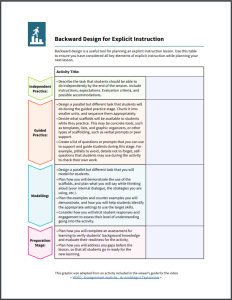Sarah Calvin, OCT, Producer of Bilingual Educational Content with the LD@school team
“Explicit instruction is a group of research-supported instructional behaviors used to design and deliver instruction that provides needed supports for successful learning through clarity of language and purpose, and reduction of cognitive load. It promotes active student engagement by requiring frequent and varied responses followed by appropriate affirmative and corrective feedback, and assists long-term retention through use of purposeful practice strategies” (Hughes, Morris, Therrien, & Benson, 2017, p. 143).
Introduction
Explicit instruction is an evidence-based practice for teaching students with learning disabilities (LDs). This means that a vast amount of research, conducted over many decades, support the use of this practice with students with LDs.
To learn more about the research behind explicit instruction, click here to access the article Explicit Instruction: A Teaching Strategy in Reading, Writing, and Mathematics for Students with Learning Disabilities.
There are many theories about why explicit instruction is effective for these students. For one, it offers an instructional approach that reduces cognitive load (Smith, Sáez, & Doabler, 2016). For students who have not consolidated prerequisite knowledge or skills to the point of automaticity, learning new concepts can put stress on their working memory, as they attempt to hold both the prerequisite and new material in their minds at the same time. Explicit instruction reduces this cognitive load in a number of ways that will be explored throughout this article.
Some teachers may be more familiar with the term Direct Instruction. While this approach has many overlapping components with explicit instruction, it is different in that it usually includes a curriculum outlining what to teach as well as the instructional approach guiding how to teach (Hughes et al., 2017).
This article is intended to guide educators who are new to explicit instruction. The following sections provide guidelines for implementing explicit instruction at each stage of the process.
Preparing the Lesson
Explicit instruction requires careful planning. Some educators may be surprised at how challenging it can be to develop unambiguous instruction for even simple concepts (Stockard, Wood, Coughlin, & Rasplica Khoury, 2018).
Follow the guidelines below and use LD@school’s backward design template to prepare for your explicit instruction lessons.

Click here to access the template Backward Design for Explicit Instruction.
First, educators must select the content to be taught using this approach. Any skills or knowledge that are essential to students’ success in the course or in the future are considered “critical content” that should be taught using explicit instruction (Hughes et al., 2017). For example, the basic mathematical operations, paragraph-writing structure, grammar rules, collaboration and social skills, research skills, and technology use are all foundational skills for success in the classroom and beyond.
Next, decide how to chunk complex skills or content into discrete units of instruction, and in what order you will present them in your lesson. Units should be presented in an order that is logical for the given content. For example, sequencing units from simplest to most difficult may apply to some concepts but not others. It is also recommended that similar concepts be separated to prevent confusion (Watkins & Slocum, 2003, as cited in Hughes et al., 2017).
Before your lesson, it is important to verify students’ background knowledge. Some students, particularly those with LDs, may not have consolidated the prerequisite skills and knowledge to be able to keep up with the new material (Hughes et al, 2017). Using diagnostic assessment, or assessment for learning, educators can assess students’ readiness and respond accordingly, for example by teaching the prerequisite content to a small group of students while others engage in independent work.
Beginning the Lesson
Start each lesson by providing students with a clear outline of the learning goals and your expectations of them. Clearly explain what they will learn, how it is related to past learning, why it is important, and in what contexts they will be able to use the new skill or knowledge.
Activate students’ prior knowledge, and provide an “advance organizer” to bridge their prior knowledge to the new content to be covered in the lesson (Agrawal & Morin, 2016). Taking many possible forms (e.g., verbal, visual, physical), advance organizers offer students a framework to organize and interpret new information. For example, provide a graphic organizer to demonstrate the logical organization of the information and help students see the relationships among concepts. The use of graphic organizers is another evidence-based practice for students with LDs, and have been associated with improved in vocabulary, comprehension, and inferential knowledge (Dexter & Hughes, 2011). For more information, click here to access the article Graphic Organizers.
Delivering the Lesson
An essential component of explicit instruction is frequent opportunities for student responses and engagement (Hughes et al., 2017). Consider how you will elicit student responses throughout the lesson, whether students will be engaging individually, in dyads, or in groups. Also consider how you will offer accommodations and scaffolding for student responses. For example, you may phrase your questions with multiple choice answer options, or provide some students with sentence starters (Hughes et al., 2017).
Stage 1: Modelling
During the modelling stage of the lesson, the educator performs a “show & tell” of the skill being taught.
Show by modelling the skill that students will need to master, following the chunking and sequencing that you determined in the planning phase. Provide a wide variety of examples to help students understand the various contexts in which the target skill can be applied. Provide a handful of counterexamples as well to help students understand the common pitfalls or limits of the concept (Alphonse & Leblanc, 2014).
Tell by thinking aloud while you perform the task, explicitly stating the what, why, how, when and where. Use vocabulary that is:
- Clear: Use words appropriate to students’ developmental stage and comprehension level.
- Concise: Avoid unnecessarily wordy or tangential explanations, which can be particularly difficult for students with LDs to follow.
- Consistent: Repeat similar terminology throughout the lesson to improve students’ familiarity with the key words.
(Hughes et al., 2017)
Research suggests that a brisk pace is most appropriate for presenting information; note that this does not mean rushed, but rather quick enough to maintain attention while avoiding digressions, classroom interruptions, or pauses due to a lack of preparation for the lesson (Hughes et al., 2017).
Stage 2: Guided Practice
During the modelling stage of the lesson, students engage in purposeful practice opportunities of the target skill. Throughout this stage, provide appropriate levels of scaffolding through physical, visual, or verbal prompts. What is considered appropriate levels of scaffolding will be different for each student and will depend on the amount of time they have been practicing. Adjust accordingly, gradually reducing scaffolding as students become more proficient.
At this stage, students may work independently, in dyads, or in groups, each of which offers different opportunities for scaffolding from the teacher and from peers. Whatever the grouping, remember that practice is most effective when followed by affirmative or corrective feedback (Hattie & Yates, 2014), and so this must be considered in planning guided practice opportunities.
Stage 3: Independent Practice
Finally, during independent practice, students practice the target skill without the prompts that were available during the guided practice stage, giving them the opportunity to consolidate their understanding and ultimately achieve mastery of the skill.
Although students practice independently at this stage, educators should still closely monitor students in order to assess their use of the skills and progress toward mastery. Educators should be particularly attentive to students with LDs, who may require additional time at the previous stages (Alphonse & Leblanc, 2014).
Conclusion
Given the robust evidence supporting the use of explicit instruction for students with LDs, all educators should gain familiarity with this approach and evaluate their practice to determine new ways in which it may be integrated to better support all students.
Learning is enhanced only when the information presented is explicit, logically organized, and clearly sequenced. To do anything less shirks the responsibility of effective instruction (Stockard, Wood, Coughlin, & Rasplica Khoury, 2018).
It is important to note, however, that explicit instruction is not the only teaching approach suited for students with LDs. These students, like all students, benefit from a variety of approaches judiciously chosen to suit the given content and learning objectives.
Related Resources on the LD@school Website
Click here to access the article Direct Instruction of Reading for Elementary-Aged Students.
Click here to access the article Explicit Instruction of Self-Advocacy Skills.
Click here to access the article Strategies to Assist Students with LDs.
References
Agrawal, J., & Morin, L. L. (2016). Evidence‐based practices: Applications of concrete representational abstract framework across math concepts for students with mathematics disabilities. Learning Disabilities Research & Practice, 31(1), 34-44.
Alphonse, J. R. & Leblanc, R. (2014). Explicit Instruction: A Teaching Strategy in Reading, Writing, and Mathematics for Students with Learning Disabilities. Retrieved from https://www.ldatschool.ca/explicit-instruction-a-teaching-strategy-in-reading-writing-and-mathematics-for-students-with-learning-disabilities/
Dexter, D. D., & Hughes, C. A. (2011). Graphic organizers and students with learning disabilities: A meta-analysis. Learning Disability Quarterly, 34(1), 51-72.
Hattie, J., & Yates, G. (2014). Visible learning and the science of how we learn. New York: Routledge.
Hughes, C. A., Morris, J. R., Therrien, W. J., & Benson, S. K. (2017). Explicit instruction: Historical and contemporary contexts. Learning Disabilities Research & Practice, 32(3), 140-148.
Smith, J. L. M., Sáez, L., & Doabler, C. T. (2016). Using explicit and systematic instruction to support working memory. TEACHING Exceptional Children, 48(6), 275-281.
Stockard, J., Wood, T. W., Coughlin, C., & Rasplica Khoury, C. (2018). The effectiveness of direct instruction curricula: A meta-analysis of a half century of research. Review of Educational Research, 88(4), 479-507.
 Sarah Calvin is a Producer of Bilingual Educational Content for LD@school and TA@l’école. She holds a Bachelor of Education from the University of Toronto, and has completed one year toward a Masters of Social Work. Sarah has enjoyed her experiences working directly with students, as well as supporting teachers’ professional learning. Her favourite part of the job is collaborating with a bilingual team to produce practical resources, and to help teachers support not only their students with LDs, but all of their students.
Sarah Calvin is a Producer of Bilingual Educational Content for LD@school and TA@l’école. She holds a Bachelor of Education from the University of Toronto, and has completed one year toward a Masters of Social Work. Sarah has enjoyed her experiences working directly with students, as well as supporting teachers’ professional learning. Her favourite part of the job is collaborating with a bilingual team to produce practical resources, and to help teachers support not only their students with LDs, but all of their students.
